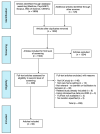Identifying barriers and facilitators to the inclusion of older adults living in UK care homes in research: a scoping review
- PMID: 37474927
- PMCID: PMC10360346
- DOI: 10.1186/s12877-023-04126-3
Identifying barriers and facilitators to the inclusion of older adults living in UK care homes in research: a scoping review
Abstract
Background: With an ageing population, older adults will have more complex health and social care needs and many of these older adults will be living in care homes. Despite the growth in care home populations, care home residents are often excluded from research that could potentially benefit their care. The purpose of this scoping review is to explore resident-related barriers and facilitators to including older people living in UK care homes in research and to identify potential approaches to modify such barriers.
Method: The 6-stage scoping review methodology framework proposed by Arksey and O'Malley guided this review. Five electronic databases (MedLine, PsychINFO, Scopus, Web of Science, CINAHL) and grey literature were searched. Identified articles went through two levels of screening, and those deemed relevant were collated, summarised and reported using a thematic analysis approach.
Results: 90 reports were eligible for inclusion and were synthesised into 7 themes and related subthemes: (1) research design; (2) understanding and beliefs about research (resident and care home staff); (3) communication; (4) relationships; (5) eligibility criteria (resident and care home); (6) preference-based decisions; and (7) care home staff and environment. Given the complex interplay of the factors identified, both direct and indirect factors were included.
Conclusions: A number of recurring barriers and facilitators to the inclusion of care home residents in research are reported. However, isolating resident-related barriers was complex as both direct and indirect factors must be considered as influential. Understanding the barriers and facilitators to inclusion will enable these factors to be addressed and increase the evidence-base for care provided to older people living in care homes.
Keywords: Barriers; Care home; Facilitators; Inclusion; Nursing home; Older adults; Participation; Research; Residential home; Scoping review.
© 2023. The Author(s).
Conflict of interest statement
The authors declare that they have no competing interests.
Figures
References
-
- Office for National Statistics . Wealth and assets survey 2015. London: ONS; 2015.
-
- Office for National Statistics . Care home and non-care home populations used in the deaths involving COVID-19 in the care sector article, England and Wales. London: ONS; 2020.
-
- Public Health Scotland. Care home census for adults in Scotland; 2019.
-
- Department of Health. Statistics on community care for adults in Northern Ireland 2019/2020; 2020.
-
- Wittenberg R, Hu B, Barraza-Araiza L, Rehill A. Projections of older people with dementia and costs of dementia care in the United Kingdom, 2019–2040. London: London School of Economics; 2019.
Publication types
MeSH terms
Grants and funding
LinkOut - more resources
Full Text Sources
Medical


